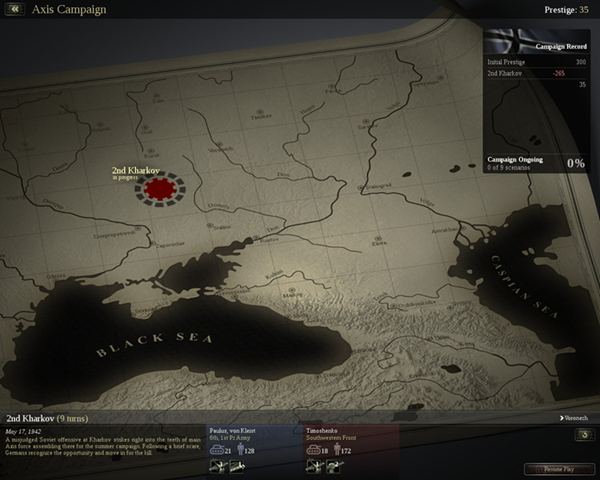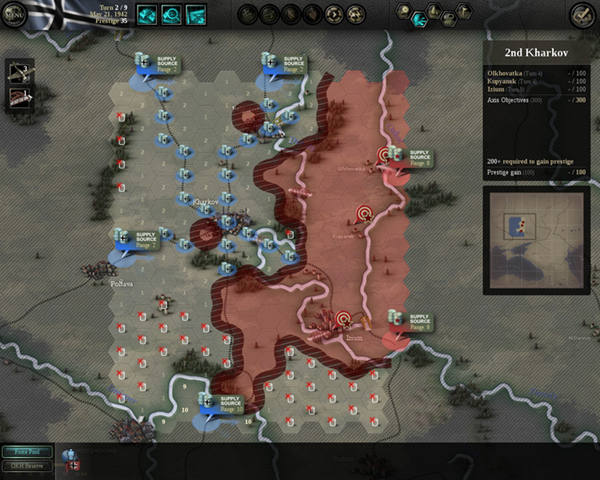Unity of Command – PC Game Review
 Unity of Command. PC Game Review. Publisher: Slitherine/Matrix Games. Developer: 2×2 Games. $29.99 (Digital Download) $39.99 (Boxed)
Unity of Command. PC Game Review. Publisher: Slitherine/Matrix Games. Developer: 2×2 Games. $29.99 (Digital Download) $39.99 (Boxed)
Passed Inspection: Fine history, good campaign, great AI, simple mechanics.
Failed Basic: Quirky graphics, screen resolution problems.
If the Battle of Kursk in 1943 marked the end of German offensive power in the East, the campaign that started in 1942 was the instrument that sapped the Wehrmacht’s strength. Although this string of battles is usually remembered for Stalingrad, that sink of good troops and resources did not figure into the initial strategic goal: the seizure of the oilfields in the Caucasus Mountains. The madness of Stalingrad was a mixture of inexorable operational forces and Hitler’s ego and strategic short-sightedness. Slitherine/Matrix Games’ and 2X2 Games’ Unity of Command offers great insight into the German offensive and the Russian counter-offensive.
{default}The Boring Kind of Busts
Unity of Command presents graphics only a grognard could love. The map is primarily a study in grays with brick red splotches showing Russian positions. Some terrain items like cities, large forests, rivers, roads, and bridges are shown clearly and overlays display supply, objectives, moving weather fronts and hex grids with equal clarity. Utilitarianism is fine for planning if not excitement. The drabness is alleviated by the bright orange borders and boundaries popping up when a unit is selected to move. Black boundaries and arrows show possible extended moves with available points at the end of moves. The unit symbols on the replacement/reinforcement add color as well as the asset icons. Planes swooping down to strike are nice touches.

The rub comes with the unit icons. Infantry and cavalry units are busts springing up from the ground like warriors from a Greek myth. Armor units are shown as tanks and mech infantry as busts with trucks. Plenty of information is shown on the icons: strength steps, specialist steps, movement and attack points, experience level, and entrenchment. However, if players’ screen resolution is over 1240, they have to squint to see all the icon data. Possible solutions, since no zoom or sizing options come with the game, are changing the desktop resolution or the config file. Fortunately, an information sheet repeats the data, albeit with small font. Modders are already working on alternative icons.
Sound effects are the usual boom, zoom, and tramp, although objective captures cause a nice trumpet sound. The 45-page manual is well done and a tutorial and introductory scenario helps with learning the mechanics.
Down and Out in Kharkov
Battles are ground out on an operational level on twenty-kilometer hexes in four-day turns. German units represent divisions while the Russian units are corps; in reality, a Russian corps was roughly the size of a German division. These points are seen in rows of dots across icons and info sheets with blue dots representing active points and grey as suppressed. Points are lost in succession so, since specialist steps are in the middle of the row, they usually survive the first onslaught. The usual attack, defense, and movement attributes are shown in the info sheet but the real differential for performance is experience. Four levels of experience can increase units’ combat abilities. Experience is gained by destroying enemy points. Surprisingly similar to RPGs, units can “level up” during a game.

Movement also has unusual elements. Normal movement ends with the ability to attack and successful attacks may yield more space to move and initiate a second battle. Hitting the spacebar allows units to move farther with extended movement but reduces combat ability. After combat, units may be able to move toward the rear, allowing fresh formations to come up and continue the push. Such maneuvers may be stopped by strong enemies’ zones of control or by terrain and weather
Supply is the quiet coefficient in this game. Emanating from supply centers, supply points diminish like movement points so forward forces can outrun their resources. Railroads are exempt from this distance reduction system. Naturally, supply is blocked by enemy units. If a unit is out of supply for one turn, it cannot recover suppressed points; if out of supply for two turns, no recovery and no attack points; three turns and no attacks, all steps suppressed, and one movement point loss; more than three turns, movement is even more limited. Experience plays a role in the number of suppressed points and speed of recovery.
Drive to Oblivion
Combat in Unity of Command is spelled out as in board games. The raw strength ratio is modified by shifts for armor, weather, terrain, entrenchment and experience. Specialist units also provide shifts in particular situations. These units include anti-tank units, armor, artillery, anti-air, engineers, and recon. Russian units can also be blessed with NKVD personnel who discourage retreats. The accumulative shift total is shown in the info sheet as positive or negative to the attacker. Probable losses in suppressed points for both sides are displayed as are probability of retreats and overruns. Losses can be replaced by “reorganizing” units and giving their steps to other formations at a cost of prestige.
Depending on the scenario, both sides may have theater assets including air, bridge building or destruction, and increasing logistics. Russians have partisans to disrupt German supply. These assets can be used limited times each turn.
The carnage is played out in ten German scenarios and seven Russian ones categorized by easy, medium, and hard. Players can’t play the other side against the AI but both sides are playable against human opponents in hotseat or Internet mode. Scenarios are time-limited with specific objectives whose value decreases as the battle plays on. Victory levels are “victory”, ‘decisive victory” and “brilliant victory.” These levels are determined by how quickly the objectives are taken plus remaining prestige points. Prestige points are the game’s currency of the realm. They are spent by adding replacement steps and buying specialist units or more divisions from reserves. STAVKA and OKH frown on such requests, thus doing without reinforcements improves victory levels.

Victory levels and the accompanying victory points come into their own in the campaign games. The German campaign starts in May 1942 with 2nd Kharkov. Mediocre players will end up in Stalingrad four battles later while better players may strike east or a bit to the south. Brilliant players will win all ten scenarios and luxuriate in the oilfields of Baku. The Russian campaign begins with the URANUS counter-attack in November and can either end with the historical whimper west of Stalingrad or with a crushing defeat of Army Group South to the northwest. The route taken by either side depends on players’ ability to win battles quickly and on gaining prestige.
Players who make it through to the end of the longest campaign branch may well be as brilliant as the required victories because the AI is brutal. Always on the defensive due to the scenarios’ structure, it seeks out gaps and weak units to counter-attack through the human’s line. Supply gets disrupted and units attempting to recover from bashings can be savaged. Such lunges seem suicidal because the lead units can easily be isolated and annihilated. Yet, the time and resources spent mopping up rear areas are often the difference between a “decisive victory” or a mediocre one. If no weakness appears in the player’s line, the computer puts up a solid wall on good defensive ground, trading space for time. The AI knows what players must do and is a dab hand at frustrating efforts. Winning strategies demand a balance of hammer blows with armor and solid support with infantry. A nice replay function called “history mode” allows players to mull over their mistakes or relish their triumphs.
Unity of Command is not a game for dilettantes. Players should hold off on the beer and pretzels. The product’s historical accuracy and grand AI underline the operational feel of the Eastern Front. No gamer interested in the clash of giants in the East should be without it.
Armchair General Rating: 88%
About the Author
Jim Cobb has been playing board wargames since 1961 and computer wargames since 1982. He has been writing incessantly since 1993 to keep his mind off the drivel he dealt with as a bureaucrat. He has published in Wargamers Monthly, Computer Gaming World, Computer Games Magazine, Computer Games Online, CombatSim, Armchair General, Subsim, Strategyzone Online.


Is it just me, or are reviews getting shorter around here?
This game is on special at macgamestore.com, going to pick it up for $10. More interested in facing an human opponent, but having a good AI to practice with should be fun.